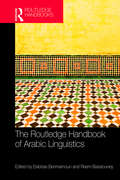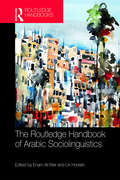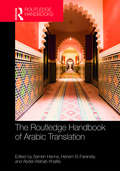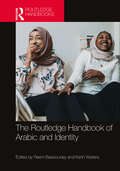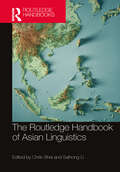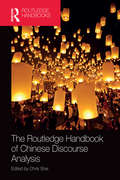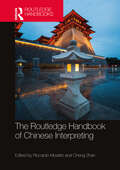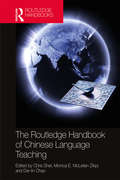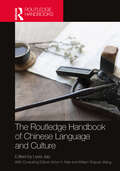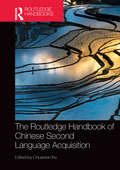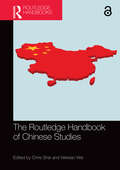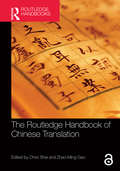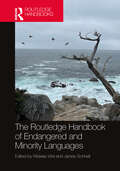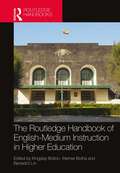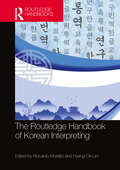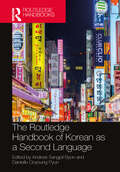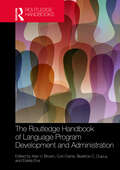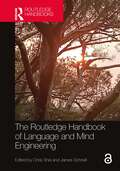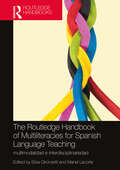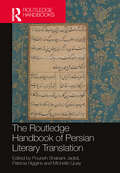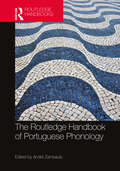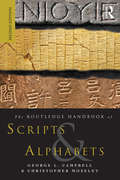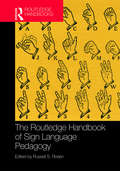- Table View
- List View
The Routledge Handbook of Arabic Linguistics (Routledge Language Handbooks)
by Elabbas Benmamoun Reem BassiouneyThe Routledge Handbook of Arabic Linguistics introduces readers to the major facets of research on Arabic and of the linguistic situation in the Arabic-speaking world. The edited collection includes chapters from prominent experts on various fields of Arabic linguistics. The contributors provide overviews of the state of the art in their field and specifically focus on ideas and issues. Not simply an overview of the field, this handbook explores subjects in great depth and from multiple perspectives. In addition to the traditional areas of Arabic linguistics, the handbook covers computational approaches to Arabic, Arabic in the diaspora, neurolinguistic approaches to Arabic, and Arabic as a global language. The Routledge Handbook of Arabic Linguistics is a much-needed resource for researchers on Arabic and comparative linguistics, syntax, morphology, computational linguistics, psycholinguistics, sociolinguistics, and applied linguistics, and also for undergraduate and graduate students studying Arabic or linguistics.
The Routledge Handbook of Arabic Sociolinguistics
by Enam Al-Wer Uri HoreshThe Routledge Handbook of Arabic Sociolinguistics comprises 22 chapters encompassing various aspects in the study of Arabic dialects within their sociolinguistic context. This is a novel volume, which not only includes the traditional topics in variationist sociolinguistics, but also links the sociolinguistic enterprise to the history of Arabic and to applications of sociolinguistics beyond the theoretical treatment of variation. Newly formed trends, with an eye to future research, form the backbone of this volume. With contributions from an international pool of researchers, this volume will be of interest to scholars and students of Arabic sociolinguistics, as well as to linguists interested in a concise, rounded view of the field.
The Routledge Handbook of Arabic Translation
by Hanem El-Farahaty Sameh Hanna Abdel Wahab KhalifaTranslation-related activities from and into Arabic have significantly increased in the last few years, in both scope and scale. The launch of a number of national translation projects, policies and awards in a number of Arab countries, together with the increasing translation from Arabic in a wide range of subject areas outside the Arab World – especially in the aftermath of the Arab Spring – have complicated and diversified the dynamics of the translation industry involving Arabic. The Routledge Handbook of Arabic Translation seeks to explicate Arabic translation practice, pedagogy and scholarship, with the aim of producing a state-of-the-art reference book that maps out these areas and meets the pedagogical and research needs of advanced undergraduate and postgraduate students, as well as active researchers.
The Routledge Handbook of Arabic and Identity
by Keith Walters Reem BassiouneyThe Routledge Handbook of Arabic and Identity offers a comprehensive and up-to-date account of studies that relate the Arabic language in its entirety to identity. This handbook offers new trajectories in understanding language and identity more generally and Arabic and identity in particular. Split into three parts, covering ‘Identity and Variation’, ‘Identity and Politics’ and ‘Identity Globalisation and Diversity’, it is the first of its kind to offer such a perspective on identity, linking the social world to identity construction and including issues pertaining to our current political and social context, including Arabic in the diaspora, Arabic as a minority language, pidgin and creoles, Arabic in the global age, Arabic and new media, Arabic and political discourse. Scholars and students will find essential theories and methods that relate language to identity in this handbook. It is particularly of interest to scholars and students whose work is related to the Arab world, political science, modern political thought, Islam and social sciences including: general linguistics, sociolinguistics, discourse analysis, anthropological linguistics, anthropology, political science, sociology, psychology, literature media studies and Islamic studies.
The Routledge Handbook of Asian Linguistics
by Chris Shei Saihong LiThe Routledge Handbook of Asian Linguistics provides a comprehensive overview of the ways in which Asian languages should be conceptualized as a whole, the distinct characteristics of each language group, and the relationships and results of interactions between the languages and language families in Asia. Asia is the largest and the most populous continent on Earth, and the site of many of the first civilizations. This Handbook aims to provide a systematic overview of Asian languages in both theoretical and functional perspectives, optimally combining the two in intercultural settings. In other words, the text will provide a reference for researchers of individual Asian languages or language groups against the background of the entire range of Asian languages. Not only does the Handbook act as a reference to a particular language, it also connects each language to other Asian languages in the perspective of the entire Asian continent. Cultural roles and communicative functions of language are also emphasized as an important domain where the various Asian languages interact and shape each other. With extensive coverage of both theoretical and applied linguistic topics, The Routledge Handbook of Asian Linguistics is an indispensable resource for students and researchers working in this area.
The Routledge Handbook of Chinese Discourse Analysis
by Chris SheiChinese is a discourse-oriented language and the underlying mechanisms of the language involve encoding and decoding so the language can be correctly delivered and understood. To date, there has been a lack of consolidation at the discourse level such that a reference framework for understanding the language in a top-down fashion is still underdeveloped. The Routledge Handbook of Chinese Discourse Analysis is the first to showcase the latest research in the field of Chinese discourse analysis to consolidate existing findings, put the language in both theoretical and socio-functional perspectives, offer guidance and insights for further research and inspire innovative ideas for exploring the Chinese language in the discourse domain. The book is aimed at both students and scholars researching in the areas of Chinese linguistics and discourse analysis.
The Routledge Handbook of Chinese Interpreting (Routledge Handbooks in Translation and Interpreting Studies)
by Riccardo Moratto Cheng ZhanThis Handbook sheds light on the current trends in interpretation research, with a particular focus on China and Chinese interpreting.Over the years, the field of Chinese interpreting has experienced remarkable growth, not only in terms of market demand but also in research trends within the discipline of translation studies. In China, specifically, interpretation studies have been at the forefront of developments in pioneering new approaches and methodologies. The chapters in this Handbook delve into various aspects of interpretation research, encompassing both theoretical frameworks and practical applications. From examining the intricacies of consecutive and simultaneous interpretation to exploring the role of technology in shaping the future of the profession, the contributors offer valuable insights into the advancements and challenges within Chinese interpreting. By showcasing the latest research trends and sharing valuable experiences from renowned scholars and practitioners, this collection contributes to the ongoing dialogue surrounding interpretation studies.This Handbook is a comprehensive resource for academics, researchers, students, and professionals seeking to deepen their understanding of Chinese interpreting and its evolving landscape.
The Routledge Handbook of Chinese Language Teaching
by Der-Lin Chao Chris Shei Monica E McLellan ZikpiThe Routledge Handbook of Chinese Language Teaching defines Chinese language teaching in a pedagogical, historical, and contemporary context. Throughout the volume, teaching methods are discussed, including the traditional China-based approach, and Western methods such as communicative teaching and the immersion program. The Handbook also presents a pedagogical model covering pronunciation, tones, characters, vocabulary, grammar, and the teaching of listening, speaking, reading, and writing. The remaining chapters explore topics of language assessment, technology enhanced instruction, teaching materials and resources, Chinese for specific purposes, classroom implementation, social contexts of language teaching and language teaching policies, and pragmatics and culture. Ideal for scholars and researchers of Chinese language teaching, the Handbook will benefit educators and teacher training programs. This is the first comprehensive volume exploring the growing area of Chinese language pedagogy.
The Routledge Handbook of Chinese Language and Culture (Routledge Language Handbooks)
by Victor H. Mair Liwei Jiao William Shiyuan WangThe Routledge Handbook of Chinese Language and Culture represents the first English anthology that delves into the fascinating and thought-provoking relationship between the Chinese language and culture, exploring various macro and micro perspectives.Chinese culture boasts a history of ten thousand years, while the Chinese language’s recorded history spans at least three thousand years, dating back to the Shang dynasty oracle bone inscriptions (OBI).This handbook is comprised of 17 chapters from 18 scholars including Victor Mair and William S-Y. Wang. Many chapters approach their respective topics with a comprehensive and historical outlook. Certain extensive subjects are addressed in multiple chapters, complementing one another. These topics include: The languages and peoples of China, and the southern Chinese dialects Mandarin’s evolution into a national language and its related writing reforms Language as a propaganda tool in the Cultural Revolution and in contemporary China Chinese idioms and colloquialisms This book offers an approachable exploration of the subject, appealing to both specialists and enthusiasts of the Chinese language and culture.
The Routledge Handbook of Chinese Second Language Acquisition (Routledge Language Handbooks)
by Chuanren KeThe Routledge Handbook of Chinese Second Language Acquisition is the first reference work of its kind. The handbook contains twenty contributions from leading experts in the field of Chinese SLA, covering a wide range of topics such as social contexts, linguistic perspectives, skill learning, individual differences and learning settings and testing. Each chapter covers historical perspectives, core issues and key findings, research approaches, pedagogical implications, future research direction and additional references. The Routledge Handbook of Chinese Second Language Acquisition is an essential reference for Chinese language teachers and researchers in Chinese applied linguistics and second language acquisition.
The Routledge Handbook of Chinese Studies
by Chris Shei and Weixiao WeiThis Handbook approaches Chinese Studies from an interdisciplinary perspective while attempting to establish a fundamental set of core values and tenets for the subject, in relation to the further development of Chinese Studies as an academic discipline. It aims to consolidate the current findings in Chinese Studies, extract the essence from each affiliated discipline, formulate a concrete set of ideas to represent the ‘Chineseness’ of the subject, establish a clear identity for the discipline and provide clear guidelines for further research and practice. Topics included in this Handbook cover a wide spectrum of traditional and newly added concerns in Chinese Studies, ranging from the Chinese political system and domestic governance to international relations, Chinese culture, literature and history, Chinese sociology (gender, middle class, nationalism, home ownership, dating) and Chinese opposition and activism. The Handbook also looks at widening the scope of Chinese Studies (Chinese psychology, postcolonialism and China, Chinese science and climate change), and some illustrations of innovative Chinese Studies research methods. The Routledge Handbook of Chinese Studies is an essential reference for researchers and scholars in Chinese Studies, as well as students in the discipline.
The Routledge Handbook of Chinese Translation (Routledge Language Handbooks)
by Chris Shei Zhao-Ming GaoThe Routledge Handbook of Chinese Translation presents expert and new research in analysing and solving translation problems centred on the Chinese language in translation. The Handbook includes both a review of and a distinctive approach to key themes in Chinese translation, such as translatability and equivalence, extraction of collocation, and translation from parallel and comparable corpora. In doing so, it undertakes to synthesise existing knowledge in Chinese translation, develops new frameworks for analysing Chinese translation problems, and explains translation theory appropriate to the Chinese context. The Routledge Handbook of Chinese Translation is an essential reference work for advanced undergraduate and postgraduate students and scholars actively researching in this area.
The Routledge Handbook of Endangered and Minority Languages (Routledge Handbooks of Language Learning in the Global Context)
by Weixiao Wei James SchnellThe Routledge Handbook of Endangered and Minority Languages addresses the urgent need for comprehensive language documentation and a deeper understanding of language identity, emphasizing the preservation of endangered languages.This book argues that safeguarding linguistic diversity enriches global cultural heritage and knowledge. By meticulously documenting minority languages, we not only preserve words and grammar but also the unique cultural narratives they carry. The book also introduces new language learning paradigms that recognize the complexities of multilingual societies, advocating for educational systems that embrace the diverse linguistic backgrounds of students. These approaches aim to create more inclusive and effective learning environments by valuing multilingualism. Exploring the fluid nature of language identity, the book examines how sociopolitical contexts and technology influence it, calling for policies that respect linguistic rights and promote social cohesion. It presents case studies from diverse regions, including the Pacific, Nordic countries, Cornwall, Pakistan, the UAE, and more, offering practical strategies for language preservation and revitalization.Groundbreaking insights into the use of digital tools, social media, and AI in language preservation, along with the challenges and successes of various revitalization efforts, make this book a valuable resource for researchers, educators, and policymakers committed to fostering linguistic diversity and equity worldwide.
The Routledge Handbook of English-Medium Instruction in Higher Education (Routledge Handbooks in Linguistics)
by Kingsley Bolton Werner Botha Benedict LinThis Handbook discusses the theoretical and disciplinary background to the study of English-medium instruction (EMI) in higher education worldwide. It highlights issues relating to EMI pedagogy, varying motivations for EMI education, and the delivery of EMI in diverse contexts across the world. The spread of English as a teaching medium and the lingua franca of the academic world has been the subject of various debates in recent years on the perceived hegemony of the English language and the ‘domain loss’ of non-English languages in academic communication. Encompassing a wide range of contributions to the field of EMI, the chapters of this Handbook are arranged in four distinct parts: Part I provides an overview of English-medium instruction in higher education worldwide; Part II focusses on EMI in Europe; Part III on EMI in the Middle East, North Africa, and Sub-Saharan Africa; and Part IV on EMI in the Asian region. The overall scope and level of expertise of this Handbook provides an unrivalled overview of this field of education. It serves as an essential reference for many courses dealing with applied linguistics, English language education, multilingualism, sociolinguistics, and related subjects at many levels of education, including Master’s and PhD-level studies. This Handbook serves as a valuable edition for university libraries across the world and an essential read for many faculty, undergraduate and postgraduate students, educators, and policymakers.
The Routledge Handbook of German Language Teaching
by Ruth Whittle Angela KaltThe Routledge Handbook of German Language Teaching evaluates and addresses multifaceted, multilevel needs of students and teachers within teaching German as a foreign, as well as a second, language through taking a transcultural approach.Each contribution starts with the author situating themselves in the geographical and institutional context in which they teach as well as the way in which they teach, for example, in person or online. This acknowledges the Handbook’s internationally widespread contributors, from countries with different histories in terms of cultural, linguistic and educational diversity more generally and the teaching of German in particular. The chapters reflect their voices and consider language learners as people who have their own identities.Material such as plays, poems, short literary texts, rap, singing and drawing are discussed in this book as being influential for language learners from beginner level and beyond. This book proposes that ‘learning’ happens by both the teachers and the learners going on a journey and both changing the outlook on each other and themselves along that journey. Alongside this, questions are asked with respect to curricula and the relation between speaking German and ‘belonging’ in a German-speaking country.This Handbook will primarily appeal to teachers and instructors of German, as well as those training to become German language instructors. Moreover, the book will appeal to researchers interested in the linguistic and theoretical aspects of German language teaching.
The Routledge Handbook of Korean Interpreting (Routledge Handbooks in Translation and Interpreting Studies)
by Riccardo Moratto Hyang-Ok LimProfessor Riccardo Moratto and Professor Hyang-Ok Lim bring together the most authoritative voices on Korean interpreting. The first graduate school of interpretation and translation was established in 1979 in South Korea. Since then, not only has the interpretation and translation market grown exponentially, but so too has research in translation studies. Though the major portion of research focuses on translation, interpretation has not only managed to hold its own, but interpretation studies in Korea have been a pioneer in this field in Asia. This handbook highlights the main interpretation research trends in South Korea today, including case studies of remote interpreting during the Covid-19 pandemic, Korean interpreting for conferences, events, and diplomacy, and research into educating interpreters effectively. An essential resource for researchers in Korean interpreting, this handbook will also be very valuable to those working with other East Asian languages.
The Routledge Handbook of Korean as a Second Language
by Andrew Sangpil Byon Danielle Ooyoung PyunThe Routledge Handbook of Korean as a Second Language aims to define the field and to present the latest research in Korean as a second language (KSL). It comprises a detailed overview of the field of KSL teaching and learning, discusses its development, and captures critical cutting-edge research within its major subfields. As the first handbook of KSL published in English, this book will be of particular interest to advanced undergraduates, graduate students, language teachers, curriculum developers, and researchers in the fields of KSL and applied linguistics. While each chapter will be authored by internationally renowned scholars in its major subfields, the handbook aims to maintain accessibility so that it can also be of value to non-specialists.
The Routledge Handbook of Language Program Development and Administration
by Alan V. BrownSecond language program development and administration is a long-standing area within the larger field of applied linguistics. In many ways, it is the quintessential applied linguistics field, as it crosses disciplinary boundaries while balancing the rigors of scholarly inquiry with the demands of practical application without losing sight of concrete learner outcomes.The Routledge Handbook of Language Program Development and Administration provides a scholarly rigorous, yet practically relevant treatment of issues implicated in program development and administration with 52 chapters written by leading scholars in the field. Authors not only address the theoretical underpinnings of their respective topics but also provide actionable, evidence-based recommendations concerning eminently practical matters. In this way, the volume provides both novice and experienced language program administrators with important guidance on how to think about the work that they do and how best to go about it, while also validating language program administration as a scholarly area of inquiry.The Routledge Handbook of Language Program Development and Administration is essential reading for practicing second language program administrators at the post-secondary level, in-service and pre-service second language instructors, graduate students in applied linguistics, and even upper-level undergraduate education students considering second language teaching as a future career.
The Routledge Handbook of Language and Mind Engineering
by Chris Shei James SchnellThe Routledge Handbook of Language and Mind Engineering is a comprehensive work that delves into the complex interplay between language, culture, politics, and media in shaping the human mind.The book is divided into five main sections, each exploring different aspects of mind engineering: I. Political Mind Engineering; II. Commercial Mind Engineering; III. Media, Culture, and Mind Engineering; IV. Linguistic and Semiotic Analysis of Mind Engineering; V. Mind Engineering in Educational Settings.The book provides a multi-dimensional perspective on how language, media, culture, and politics intersect to shape individuals' thoughts and beliefs. It highlights the diverse methods and contexts in which mind engineering occurs, making it a valuable resource for scholars, researchers, and policymakers interested in understanding the complexities of contemporary discourse and manipulation of human thought.The contents of this cutting-edge handbook will engage all undergraduate, postgraduate, PhD students and scholars, and researchers at all levels, in fields such as languages, linguistics, politics, communication studies, media studies, and psychology.Chapter 15 of this book is freely available as a downloadable Open Access PDF at http://www.taylorfrancis.com under a Creative Commons Attribution (CC-BY) International license.Chapter 17 of this book is freely available as a downloadable Open Access PDF at http://www.taylorfrancis.com under a Creative Commons Attribution‑Non Commercial‑No Derivatives (CC‑BY‑NC‑ND) 4.0 license.Chapter 18 of this book is freely available as a downloadable Open Access PDF at http://www.taylorfrancis.com under a Creative Commons Attribution-Non Commercial-No Derivatives (CC-BY-NC-ND) 4.0 license.
The Routledge Handbook of Multiliteracies for Spanish Language Teaching: multimodalidad e interdisciplinariedad (Routledge Spanish Language Handbooks)
by Manel Lacorte Elisa GironzettiThe Routledge Handbook of Multiliteracies for Spanish Language Teaching: multimodalidad e interdisciplinariedad proporciona una descripción integral y actualizada de los principales fundamentos teóricos, curriculares y pedagógicos para implementar e investigar acerca de la pedagogía para las multiliteracidades en la enseñanza del español.Escrito en español, este volumen es el primero que conecta las múltiples perspectivas disciplinarias que contribuyen a una pedagogía para las multiliteracidades y que reúne a expertos jóvenes y de renombre de todo el mundo para ofrecer las investigaciones más recientes y una visión multifacética de este campo.Las características incluyen: Treinta capítulos interdisciplinarios escritos por sesenta y dos reconocidos expertos procedentes de diferentes contextos educativos y geográficos. Cuatro secciones que integran componentes teóricos, metodológicos y prácticos: Fundamentos teóricos interdisciplinares, Fundamentos curriculares, Pedagogía de las multiliteracidades y Multiliteracidades en contextos de enseñanza. Una estructura consistente para cada capítulo con una introducción bilingüe seguida de secciones dedicadas a aspectos históricos y teóricos, aspectos metodológicos y aspectos pedagógicos. Una bibliografía recomendada y comentada para descubrir, explorar o profundizar en áreas, temas y disciplinas relevantes. Un conjunto variado de técnicas de enseñanza, muestras de lengua multimodales, diseños de actividades y pautas metodológicas. El volumen está diseñado específicamente para satisfacer las necesidades de investigadores, docentes y estudiantes de pregrado y posgrado que deseen desarrollar sus conocimientos sobre las últimas investigaciones y nuevas tendencias en el campo de las multiliteracidades aplicadas a la enseñanza del español desde una perspectiva internacional.
The Routledge Handbook of Persian Literary Translation
by Pouneh Shabani-Jadidi Patricia J. Higgins Michelle QuayThe Routledge Handbook of Persian Literary Translation offers a detailed overview of the field of Persian literature in translation, discusses the development of the field, gives critical expression to research on Persian literature in translation, and brings together cutting-edge theoretical and practical research. The book is divided into the following three parts: (I) Translation of Classical Persian Literature, (II) Translation of Modern Persian Literature, and (III) Persian Literary Translation in Practice. The chapters of the book are authored by internationally renowned scholars in the field, and the volume is an essential reference for scholars and their advanced students as well as for those researching in related areas and for independent translators of Persian literature.
The Routledge Handbook of Portuguese Phonology
by André ZampauloThe Routledge Handbook of Portuguese Phonology provides an up-to-date description of the Portuguese phonological system, including a thorough account of the fundamental concepts, data, and previous explanations, as well as the status quaestionis, directions for future research, and further reading.Divided into five parts with contributions from leading international scholars and rising stars, the book’s 23 chapters provide a thorough account of the Portuguese sound system and a range of perspectives on Portuguese phonology. This is the most comprehensive volume on Portuguese phonology written in English, and it delves into the most pressing issues and challenges regarding a wide variety of topics, such as segmental and suprasegmental phenomena; aspects concerning the interfaces between phonology and other linguistic domains; and issues on synchronic variation, diachronic change, acquisition, and the teaching of Portuguese speech prosody to non-native learners.This in-depth resource will be invaluable for researchers and advanced students of Portuguese language and linguistics, as well as those interested in phonology and linguistics more broadly.
The Routledge Handbook of Scripts and Alphabets
by George L Campbell Christopher MoseleyThe Routledge Handbook of Scripts and Alphabets is a unique reference to the main scripts and alphabets of the world. The Handbook presents over 60 alphabets covering an enormous scope of languages; from Amharic and Chinese to Thai and Cree. Full script tables are given for every language and each entry is accompanied by a detailed overview of its historical and linguistic context. New to this second edition: enhanced introduction discussing the basic principles and strategies utilized by world writing systems expanded to include more writing systems improved presentation of non-Roman scripts. organised into ancient, contemporary and autochthonous writing systems many new entries on fascinating and lesser-known writing systems This handy resource is the ideal reference for all students and scholars of language and linguistics. It has been brought to our attention that in some of the copies of the book there is an alignment error in the tables for Cyrillic Scripts (pages 88-90) and Roman Scripts (pages 140-44). Please contact us at Isabelle.Cheng@tandf.co.uk to receive replacement copies of the corrected tables, free of charge. Please accept our apologies for any inconvenience caused.
The Routledge Handbook of Sign Language Pedagogy (Routledge Language Handbooks)
by Russell S. RosenThe Routledge Handbook of Sign Language Pedagogy is the first reference of its kind, presenting contributions from leading experts in the field of sign language pedagogy. The Handbook fills a significant gap in the growing field of sign language pedagogy, compiling all essential aspects of current trends and empirical research in teaching, curricular design, and assessment in one volume. Each chapter includes historical perspectives, core issues, research approaches, key findings, pedagogical implications, future research direction, and additional references. The Routledge Handbook of Sign Language Pedagogy is an essential reference for sign language teachers, practitioners, and researchers in applied sign linguistics and first, second, and additional language learning.
The Routledge Handbook of Spanish Language Teaching (Routledge Spanish Language Handbooks)
by Javier Muñoz-Basols Manel Lacorte Elisa GironzettiThe Routledge Handbook of Spanish Language Teaching: metodologías, contextos y recursos para la enseñanza del español L2, provides a comprehensive, state-of-the-art account of the main methodologies, contexts and resources in Spanish Language Teaching (SLT), a field that has experienced significant growth world-wide in recent decades and has consolidated as an autonomous discipline within Applied Linguistics. Written entirely in Spanish, the volume is the first handbook on Spanish Language Teaching to connect theories on language teaching with methodological and practical aspects from an international perspective. It brings together the most recent research and offers a broad, multifaceted view of the discipline. Features include: Forty-four chapters offering an interdisciplinary overview of SLT written by over sixty renowned experts from around the world; Five broad sections that combine theoretical and practical components: Methodology; Language Skills; Formal and Grammatical Aspects; Sociocultural Aspects; and Tools and Resources; In-depth reflections on the practical aspects of Hispanic Linguistics and Spanish Language Teaching to further engage with new theoretical ideas and to understand how to tackle classroom-related matters; A consistent inner structure for each chapter with theoretical aspects, methodological guidelines, practical considerations, and valuable references for further reading; An array of teaching techniques, reflection questions, language samples, design of activities, and methodological guidelines throughout the volume. The Routledge Handbook of Spanish Language Teaching contributes to enriching the field by being an essential reference work and study material for specialists, researchers, language practitioners, and current and future educators. The book will be equally useful for people interested in curriculum design and graduate students willing to acquire a complete and up-to-date view of the field with immediate applicability to the teaching of the language.
